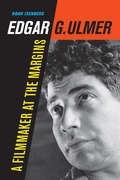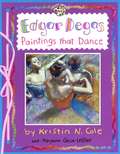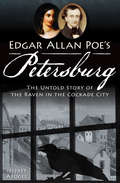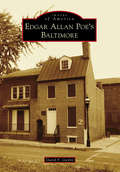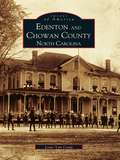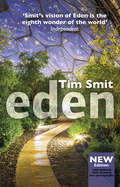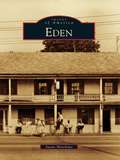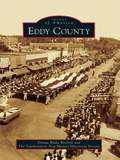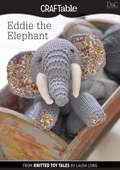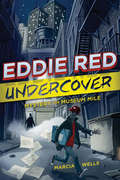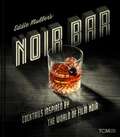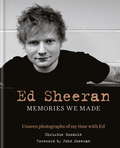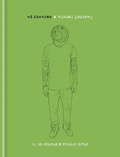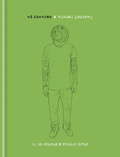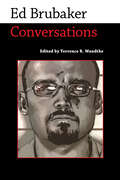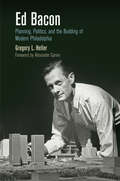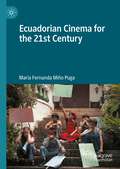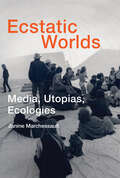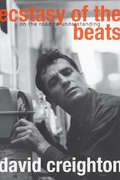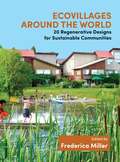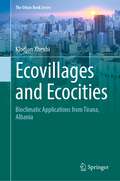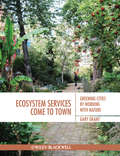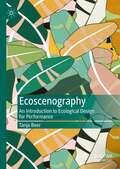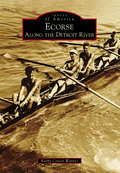- Table View
- List View
Edgar G. Ulmer: A Filmmaker at the Margins (Weimar and Now: German Cultural Criticism #48)
by Noah IsenbergEdgar G. Ulmer is perhaps best known today for Detour, considered by many to be the epitome of a certain noir style that transcends its B-list origins. But in his lifetime he never achieved the celebrity of his fellow Austrian and German émigré directors—Billy Wilder, Otto Preminger, Fred Zinnemann, and Robert Siodmak. Despite early work with Max Reinhardt and F. W. Murnau, his auspicious debut with Siodmak on their celebrated Weimar classic People on Sunday, and the success of films like Detour and Ruthless, Ulmer spent most of his career as an itinerant filmmaker earning modest paychecks for films that have either been overlooked or forgotten. In this fascinating and well-researched account of a career spent on the margins of Hollywood, Noah Isenberg provides the little-known details of Ulmer’s personal life and a thorough analysis of his wide-ranging, eclectic films—features aimed at minority audiences, horror and sci-fi flicks, genre pictures made in the U.S. and abroad. Isenberg shows that Ulmer’s unconventional path was in many ways more typical than that of his more famous colleagues. As he follows the twists and turns of Ulmer’s fortunes, Isenberg also conveys a new understanding of low-budget filmmaking in the studio era and beyond.
Edgar Degas: Paintings That Dance (Smart About Art)
by Maryann Cocca-LefflerEdgar Degas is famous for his paintings of ballerinas, and that's what first attracts Kristin to his artwork. But as she studies him for her report, she discovers that his art ranged far beyond the ballet and she gradually learns exactly what makes Degas's work so unique.
Edgar Allan Poe's Petersburg: The Untold Story of the Raven in the Cockade City
by Jeffrey AbugelVisit the Virginia city where the great author brought his thirteen-year-old bride for a honeymoon. Antebellum Petersburg was a melting pot of French, Haitian, Scotch-Irish, and free black populations. It was in this eclectic city that the master of the macabre, Edgar Allan Poe, chose to take his new wife, thirteen-year-old first cousin Virginia Clemm, on their honeymoon in 1836. This book traces the steps of the controversial couple through imaginative scenes of historic Petersburg. From Poe&’s own mother performing in the local venues to the poet&’s lasting friendship with Petersburg native and publisher Hiram Haines, it reveals an overlooked moment in the young life of this literary giant. Includes photos
Edgar Allan Poe's Baltimore
by David F. GaylinEdgar Allan Poe wrote his great works while living in several cities on the East Coast of the United States, but Baltimore's claim to him is special. His ancestors settled in the burgeoning town on the Chesapeake during the 18th century, and it was in Baltimore that he found refuge when his foster family in Virginia shut him out. Most importantly, it was here that he was first paid for his literary work. If Baltimore discovered Poe, it also has the inglorious honor of being the place that destroyed him. On October 7, 1849, he died in this city, then known as "Mob Town." Edgar Allan Poe's Baltimore is the first book to explore the poet's life in this port city and in the quaint little house on Amity Street, where he once wrote.
Edenton and Chowan County, North Carolina (Images of America)
by Louis Van CampConveniently located between three important waterways in Eastern North Carolina, Chowan County, along with its county seat of Edenton, is a remarkable community whose roots dig deeply into the 1600s when settlers arrived from Jamestown. The steadfast Perquimans River to the east, the rapidly flowing Chowan River to the west, and the serene Edenton Bay to the south have for centuries provided means of transportation, economic endeavors, and scenic views for citizens and visitors alike. By 1750, Edenton had blossomed into a distinctly rustic and bustling community, and these water canals had greatly contributed to the needs of the county's merchants, lawyers, carpenters, and plantation workers. Edenton and Chowan County, North Carolina is an engaging pictorial history that celebrates early 20th-century lifestyles enjoyed by community members of the first unofficial colonial capital. Readers will visit ancestral plantations and the ancient labor of seine net fishing, while the Norfolk and Southern railcar-steamship John W. Garrett plies once again across the Albemarle Sound. Many of the area's earlier residents are brought to life, in word and image, while they work at the Edenton Peanut Company, the Edenton Cotton Mill, and many of the old stores that lined Main Street (now Broad Street).
Eden: Updated 15th Anniversary Edition
by Tim Smit'Smit's vision of Eden is the eighth wonder of the world' Independent'Inspiring... An invaluable guide to how a large project can exceed against all odds' The Sunday Times-An updated edition of the bestselling story of the Eden Project featuring stunning new photography.At the beginning of the twenty-first century, the impossible was delivered. From the sterile depths of a disused china clay pit in Cornwall rose one of the most remarkable and ambitious ventures in recent memory. The Eden Project's Biomes, the world's largest conservatories, are the symbol of a living theatre of plants and people and their interdependence, of regeneration and of a pioneering forum for the exploration of possible futures.This is the extraordinary story of the Eden Project, of its conception, design and construction, of the larger-than-life personalities who made it happen and of all that has happened since its doors were first opened to the public in 2001. It is now undisputedly one of the world's great gardens with more than 17 million visitors flocking there and projects and partnerships all over the world.
Eden (Images of America)
by Sue MinekimeFrom its inception, Eden has been a beautiful place to call home. For generations, the fertile soils of Eden have yielded outstanding fresh produce, feeding countless individuals locally and in other states. Before the days of easy travel between places, Eden had thriving retail, commercial, and industrial areas. One business still produces that unique musical instrument, the kazoo, and thanks to inventors from Eden, tractors ride more comfortably and train travel is safer. The town produced a handful of poets, a well-known artist, a concert pianist, five state assemblymen, a state senator, and a chief judge of the State of New York Court of Appeals.
Eddy County (Images of America)
by Donna Blake Birchell The Southeastern New Mexico Historical SocietyEddy County's 4,198 square miles were carved from the massive land holdings of Lincoln County, then the largest county in the United States, on February 25, 1889. Early Spanish explorers and Native Americans had used the seemingly endless water supply of the Pecos River, which bisects the county, as a trail to the north. Seven Rivers, the first settlement in the Pecos Valley, battled the newly formed town of Eddy for the honor of remaining county seat. Eddy won by a vote of 331 for and 83 against. Although born in lawlessness and diversity, the county flourished as the discoveries of oil, gas, and potash brought industry to support the established fertile agricultural and cattle foundations. This volume explores the early founding families and pioneers and brings to light many of the long-forgotten towns of Dayton, Lookout, Oriental, and Globe that helped form the Eddy County of today.
Eddie the Elephant
by Laura LongEddie the Elephant is a gentle giant. He has big flapping ears to hear even the tiniest of sounds, but that doesn’t stop him from getting scared. The naughty little mice always try to make him jump, and when an elephant jumps, everyone knows! Eddie’s ears and feet are lined with pretty scraps of fabric, and his tail is made from a crocheted chain. Purl ridges make the wrinkles in his trunk.
Eddie Red Undercover: Mystery on Museum Mile
by Marcos Calo Marcia WellsArt, mystery, fun and friendship, combine in this illustrated middle grade series debut. Sixth grader Edmund Xavier Lonnrot, codename "Eddie Red," has a photographic memory and talent for drawing anything he sees. When the NYPD is stumped by a mastermind art thief, Eddie becomes their secret weapon to solve the case, drawing Eddie deeper into New York's famous Museum Mile and closer to a dangerous criminal group known as The Picasso Gang. With page-turning adventure and fun characters, this first installment in the Eddie Red series is a must-read for any fan of puzzles and mystery.A Spring 2014 Indies Introduce New Voices selection
Eddie Muller's Noir Bar: Cocktails Inspired by the World of Film Noir (Turner Classic Movies)
by Eddie MullerEddie Muller—host of TCM's Noir Alley, one of the world's leading authorities on film noir, and cocktail connoisseur—takes film buffs and drinks enthusiasts alike on a spirited tour through the "dark city" of film noir in this stylish book packed with equal parts great cocktail recipes and noir lore. Eddie Muller's Noir Bar pairs carefully curated classic cocktails and modern noir-inspired libations with behind-the-scenes anecdotes and insights on 50 film noir favorites. Some of the cocktails are drawn directly from the films: If you've seen In a Lonely Place and wondered what&’s in a &“Horse&’s Neck&”—now you&’ll know. If you&’re watching Pickup on South Street you&’ll find out what its director, Sam Fuller, actually drank off-screen. Didn&’t know that Nightmare Alley&’s Joan Blondell inspired a cocktail? It may become a new favorite. Meanwhile, Rita Hayworth is toasted with a "Sailor Beware," an original concoction which, like the film that inspired it (The Lady From Shanghai), is unique, complex, and packs a wallop. Featuring dozens of movie stills, poster art, behind-the-scenes imagery, and stunning cocktail photography, Noir Bar is both a stylish and exciting excursion through classic cinema&’s most popular genre.
Ed Sheeran: Unseen photographs of my time with Ed
by Christie Goodwin John Sheeran'...a fabulous book' Chris Evans (BBC Radio 2)A stunning collection of rare and unseen photographs and stories charting Ed Sheeran's rise to global superstar, by long-time collaborator Christie Goodwin.Featuring a foreword and additional photo captions by Ed's father, John Sheeran."When I first met Ed Sheeran he was unknown and unsigned - just a young busker trying to make it big. But I could see something special in Ed. I agreed to photograph him for free to help him on his way to the top. That was the beginning of a 10-year collaboration, with the two of us crossing paths as Ed became one of the biggest stars on the planet - a story told here, through my camera. Including images and stories I'm sharing for the first time, with additional captions by Ed's father John, this is an up-close and intimate view of Ed Sheeran."Christie Goodwin
Ed Sheeran: A Visual Journey
by Phillip Butah Ed Sheeran Sheeran)With words by Ed Sheeran and illustrations by his childhood friend, artist Phillip Butah (who produces artwork for Sheeran's albums and singles), and accompanying photos, Ed Sheeran: A Visual Journey is an exclusive, fully authorised, first-person account by Ed of how he became an internationally renowned singer-songwriter.In the book, Ed explores his early musical experiences and influences as well as his time recording and touring, right up to the release of his second album, 'x'. The book reveals what drives and inspires Ed as he continues to evolve as an artist, while coping with stratospheric success, and is an honest account of what it takes to make it in the music business.With Phillip Butah's distinctive portraits of Ed throughout, this is a unique book celebrating a unique musician. It includes Ed's recollections of working tirelessly on the London gig circuit and self-releasing EPs, working hard on finding his sound, signing to Asylum Records and recording his huge hit album, '+', performing at the Grammys, touring with Taylor Swift and sell-out headline gigs at Madison Square Garden. It takes us up to Ed as a musician today, including recording his new album, 'x'.
Ed Sheeran: A Visual Journey
by Phillip Butah Ed Sheeran Sheeran)**This enhanced edition includes behind-the-scenes videos of the making of the book and an exclusive message from Ed.** With words by Ed Sheeran and illustrations by his childhood friend, artist Phillip Butah (who produces artwork for Sheeran's albums and singles), and accompanying photos, Ed Sheeran: A Visual Journey is an exclusive, fully authorised, first-person account by Ed of how he became an internationally renowned singer-songwriter. In the book, Ed explores his early musical experiences and influences as well as his time recording and touring, right up to the release of his second album, 'x'. The book reveals what drives and inspires Ed as he continues to evolve as an artist, while coping with stratospheric success, and is an honest account of what it takes to make it in the music business. With Phillip Butah's distinctive portraits of Ed throughout, this is a unique book celebrating a unique musician. It includes Ed's recollections of working tirelessly on the London gig circuit and self-releasing EPs, working hard on finding his sound, signing to Asylum Records and recording his huge hit album, '+', performing at the Grammys, touring with Taylor Swift and sell-out headline gigs at Madison Square Garden. It takes us up to Ed as a musician today, including recording his new album, 'x'.
Ed Brubaker: Conversations (Conversations with Comic Artists Series)
by Terrence R. WandtkeEd Brubaker (b. 1966) has emerged as one of the most popular, significant figures in art comics since the 1990s. Most famous as the man who killed Captain America in 2007, Brubaker's work on company-owned properties such as Batman and Captain America and creator-owned series like Criminal and Fatale live up to the usual expectations for the superhero and crime genres. And yet, Brubaker layers his stories with a keen self-awareness, applying his expansive knowledge of American comic book history to invigorate his work and challenge the dividing line between popular entertainment and high art. This collection of interviews explores the sophisticated artist's work, drawing upon the entire length of the award-winning Brubaker's career. With his stints writing Catwoman, Gotham Central, and Daredevil, Brubaker advanced the work of crime comic book writers through superhero stories informed by hard-boiled detective fiction and film noir. During his time on Captain America and his series Sleeper and Incognito, Brubaker revisited the conventions of the espionage thriller. With double agents who lose themselves in their jobs, the stories expose the arbitrary superhero standards of good and evil. In his series Criminal, Brubaker offered complex crime stories and, with a clear sense of the complicated lost world before the Comics Code, rejected crusading critic Fredric Wertham's myth of the innocence of early comics. Overall, Brubaker demonstrates his self-conscious methodology in these often little-known and hard-to-find interviews, worthwhile conversations in their own right as well as objects of study for both scholars and researchers.
Ed Bacon
by Gregory L. Heller Alexander GarvinIn the mid-twentieth century, as Americans abandoned city centers in droves to pursue picket-fenced visions of suburbia, architect and urban planner Edmund Bacon turned his sights on shaping urban America. As director of the Philadelphia City Planning Commission, Bacon forged new approaches to neighborhood development and elevated Philadelphia's image to the level of great world cities. Urban development came with costs, however, and projects that displaced residents and replaced homes with highways did not go uncriticized, nor was every development that Bacon envisioned brought to fruition. Despite these challenges, Bacon oversaw the planning and implementation of dozens of redesigned urban spaces: the restored colonial neighborhood of Society Hill, the new office development of Penn Center, and the transit-oriented shopping center of Market East.Ed Bacon is the first biography of this charismatic but controversial figure. Gregory L. Heller traces the trajectory of Bacon's two-decade tenure as city planning director, which coincided with a transformational period in American planning history. Edmund Bacon is remembered as a larger-than-life personality, but in Heller's detailed account, his successes owed as much to his savvy negotiation of city politics and the pragmatic particulars of his vision. In the present day, as American cities continue to struggle with shrinkage and economic restructuring, Heller's insightful biography reveals an inspiring portrait of determination and a career-long effort to transform planning ideas into reality.
Ecuadorian Cinema for the 21st Century
by María Fernanda Miño PugaEcuadorian cinema has been largely overlooked in film scholarship, usually being limited to brief descriptions in Latin American compendiums. Ecuadorian cinema for the 21st century would be the first major publication in English to fill this gap. It provides a thorough account of film activities during the new millennium, while also referring to the country’s previous film history. Specifically, this book discusses the so-called ‘mini-boom” in Ecuadorian cinema, and its relation to industry structures, film policy, and the context of Socialism for the 21st century, hence the chosen terminology of “Ecuadorian cinema for the 21st century”. What makes this project distinctive, aside from the originality of its content, is its transdisciplinary methodology. As a means to frame the textual analysis of selected films, this book discusses theories on national cinemas, memory, political ideology, and production practices, in an interdisciplinary approach that can be emulated in later projects. For this purpose, the book is divided into five chapters, in addition to a brief introduction and conclusion. Each chapter relies on specific case studies to discuss local narratives and documentaries, whether state sponsored or privately funded, centring primarily on films that premiered in commercial theatres between 2006 and 2016.
Ecstatic Worlds: Media, Utopias, Ecologies (Leonardo)
by Janine MarchessaultWhen media translate the world to the world: twentieth-century utopian projects including Edward Steichen's “Family of Man,” Jacques Cousteau's underwater films, and Buckminster Fuller's geoscope.janine
Ecstasy of the Beats: On the Road to Understanding
by David CreightonWho were the beats? Not the sandle-clad "beatniks" of popular lore but dedicated writers, experimenters, skit improvisers, theorizers, hedonists, close friends, bisexual free lovers, shapers of the future. The beats hung out at Columbia university and cheap Times Square cafeterias, devouring ideas. David Creighton shows how the world has taken up their message. In Ecstasy of the Beats he gives a fresh portrait of Carolyn Cassady, "Queen of the Beats," and of the four major Beat writers. Jack Kerouac’s On the Road gave a pattern of adventure to restless youth, Allen Ginsberg donned a prophet’s robe by writing Howl, William Burroughs warned against control mechanisms in Naked Lunch, and Neal Cassady’s high-energy life made him an icon of freedom. Travelling widely to see where they lived, Creighton enriches the meaning of On the Road and other Beat classics. He invites the reader on the Beats’ journey toward ever-deeper levels of understanding and provides interesting insight into Kerouacs French-Canadian roots.
Ecovillages around the World: 20 Regenerative Designs for Sustainable Communities
by Frederica Miller<p>Aligning perfectly with the practices of ecovillages around the world, these initiatives show that ecovillages and sustainable communities are leading by example as we move into a future focused on partnership, environmental protection, prosperity, and peace for all life and the planet we live on. <p>Offering a visual tribute to the work ecovillages do to alleviate climate change, social conflict, and environmental damage, including more than 300 full-color photographs, maps, and diagrams, this beautiful book highlights 20 best practice designs from ecovillages around the world to show how we can live lightly on the planet no matter where on earth we live, in all climate zones and cultures. It demonstrates how ecovillages have already achieved the climate goals all of us are now striving toward through practical lifestyle changes that promote peaceful and joyful coexistence both among people and between people and nature. Far from being only aesthetic choices, these changes give an increased quality of life, healthy homes, delicious organic food, playful interdependence, a new spiritual connection to our living planet, and much more. Through their regenerative, sustainable, and peace-promoting practices, ecovillages continue the culture of traditional village living in a modern way that addresses the critical challenges of our time. <p>The book features the following 20 ecovillage projects: Hurdal Ecovillage and Hurdal Sustainable Valley, Norway; Svanholm, Denmark; Permatopia, Denmark; Solheimar, Iceland; Lilleoru, Tallin, Estonia; Findhorn, Scotland; Sieben Linden, Germany; Tamera, Portugal; Damanhur, Italy; Torri Superiore, Italy; Kibbutz Lotan, Israel; Sekem, Egypt; Chololo, Tanzania; Tasman Ecovillage, Australia; Narara, Australia; Hua Tao Ecovillage, China; Auroville, India; Ecovillage at Ithaca, New York, USA; Huehuecoyotl, Mexico; Ceo do Mapia, Brazil.
Ecovillages and Ecocities: Bioclimatic Applications from Tirana, Albania (The Urban Book Series)
by Klodjan XhexhiEcological and livable cities need an objective method to be examined. This book is in search of a method to determine the level of livability, ecology and energy efficiency. Ecological and sustainable cities need to properly make up for the existent weakness of the city's construction under fine ecological environment. The intention of this comparative study is an attempt to improve life quality in Tirana, Albania. It gives examples of successful strategies, e.g. bioclimatic solution through passive solar systems and the use of underground tunnels. This book is aimed at researches, professionals, architects and city planners.
Ecotopia 2121: A Vision for Our Future Green Utopia?in 100 Cities
by Alan MarshallA 2016 Green Book Festival "Future Forecasts" WinnerA stunningly original, lushly illustrated vision for a Green Utopia, published on the 500th anniversary of the original Big Idea.Five hundred years ago a powerful new word was unleashed upon the world when Thomas More published his book Utopia, about an island paradise far away from his troubled land. It was an instant hit, and the literati across Europe couldn't get enough of its blend of social fantasy with a deep desire for a better world. Five hundred years later, Ecotopia 2121 once again harnesses the power of the utopian imagination to confront our current problems, among them climate change, and offer a radical, alternative vision for the future of our troubled planet.Depicting one hundred cities around the globe-from New York to San Francisco, London, Tokyo, Sydney, Rio de Janeiro, Mexico City, Beijing, Vienna, Singapore, Cape Town, Abu Dhabi, and Mumbai-Alan Marshall imagines how each may survive and prosper. A striking, full-color scenario painting illustrates each city. The chapters tell how each community has found either a social or technological innovation to solve today's crises. Fifteen American cities are covered. Around the world, urban planners like to tailor scenarios for the year 2020, to take advantage of the metaphor of 20-20 vision. In Ecotopia 2121, the vision may be fuzzy, but its sharp insights, captivating illustrations, and playful storytelling will keep readers coming back again and again.
Ecosystem Services Come To Town: Greening Cities by Working with Nature
by Gary GrantThe need to find new approaches to the development of cities is becoming increasingly urgent in this age of continuing population growth, demographic transition, climate change, fossil fuel peak and biodiversity losses. Restoring ecosystem services and promoting biodiversity is essential to sustainable development – even in the built environment. Ecosystem Services come to Town: greening cities by working with nature demonstrates how to make urban environments greener. It starts by explaining how, by mimicking nature and deliberately creating habitats to provide ecosystem services, cities can become more efficient and more pleasant to live in. The history of cities and city planning is covered with the impacts of industrial urban development described, as well as the contemporary concerns of biodiversity loss, peak oil and climate change. The later sections offer solutions to the challenges of sustainable urban development by describing and explaining a whole range of approaches and interventions, beginning at the regional scale with strategic green infrastructure, looking at districts and precincts, with trees, parks and rain gardens and ending with single buildings, including with green roofs and living walls. Technical enough to be valuable to practitioners but still readable and inspirational, this guide demonstrates to town planners, urban designers, architects, engineers, landscape architects how to make cities more liveable.
Ecoscenography: An Introduction to Ecological Design for Performance
by Tanja BeerThis ground-breaking book is the first to bring an ecological focus to theatre and performance design, both in scholarship and in practice. Ecoscenography weaves environmental philosophies and practices across genres and fields to provide a captivating vision for the future of sustainable theatre production. The book forefronts leading designers that are driving this emerging field into the mainstream through their relational and reciprocal engagement with place, audiences, materials, and processes. Beyond its radical philosophy and framework, Ecoscenography makes a compelling case for pursuing an ecological ethic in theatre and performance design, not only as a moral imperative, but for the extraordinary possibilities that it offers for more-than-human engagement. Based on her personal insights as a leading ecological researcher and practitioner, Beer offers a rich resource for scholars, students and practitioners alike, opening up new processes and aesthetics of theatrical design that enhance the environmental and social advocacy of the field.
Ecorse: Along the Detroit River
by Kathy Covert WarnesFrench explorers called the Ecorse River the "river of bark," or Ecorces, because the Huron Indians who lived in the villages surrounding it wrapped their dead in the bark of the birch trees that grew along its banks. White pioneers settled on French ribbon farms along the Detroit River, and a small village called Grandport sprang up where the Ecorse River met the Detroit River. By 1836, Grandport, now known as Ecorse, had grown into a fishing and farming center, and, by the 1900s Ecorse had gained fame as a haven for bootleggers during Prohibition, an important shipbuilding center, and the home of several championship rowing teams.
